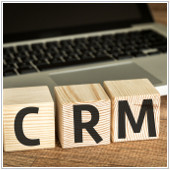 As the saying goes, “absence makes the heart grow fonder.” If oceans were to separate you from your loved ones, what would you do? Would you communicate as much as you used to? Would you still check in from time to time? Now, apply this sentiment to your business; what would happen if communication with your customers broke down? Following up on orders or keeping track with progress would become a nightmare – it’s time for CRM software to save the day:
As the saying goes, “absence makes the heart grow fonder.” If oceans were to separate you from your loved ones, what would you do? Would you communicate as much as you used to? Would you still check in from time to time? Now, apply this sentiment to your business; what would happen if communication with your customers broke down? Following up on orders or keeping track with progress would become a nightmare – it’s time for CRM software to save the day:
Since every business differs in terms of size, there is no one-size-fits-all when it comes to CRM. Thus, varying corporate sizes require unique CRM software that best addresses requirements. We’ll be taking a look at ideal CRM software options for the following categories: businesses in general, very small businesses and ones that are free.
Best CRM Software for Small Businesses: Salesforce
Salesforce has long been considered one of the top-tier CRM solutions, mainly due to its cloud-based nature coupled with full-featured capabilities that cater to businesses of every size. Typically, Salesforce is synonymous with larger enterprises, but that doesn’t mean small- and medium-sized businesses are denied the same perks. Enter Salesforce’s small business edition: with it, SMBs can utilize the robust set of CRM tools at an affordable rate.
Salesforce Small Business Solutions offer packages that are tailor-made for small businesses. With it you’ll be able to fully utilize all that Salesforce has to offer. In order for your company to really thrive, your CRM should be equipped with features such as lead generation, contact and opportunity management, sales forecasting, workflow automation as well as collaborative tools — all of which can be found in Salesforce. Also, the software is cloud-based, meaning that you can access data and files anywhere at anytime via mobile devices.
Best CRM Software for Very Small Businesses: Insightly
Underneath its simple and navigable facade lies a CRM software that is abundant with capabilities, all of which fit the bill for microbusinesses. Aside from the fact that it has the vital components small businesses really look for in CRM software, it’s also highly scalable to accommodate the growth of your company. Furthermore, Insightly is currently one of the more affordable CRM solutions on the market; there’s even a free version if you wish to test the waters. There are also paid plans available at a fraction of the price when compared with other CRM software solutions.
Even with the free version or paid plans that start at $12, Insightly doesn’t compromise utility with affordability. It comes equipped with all the vital CRM capabilities any microbusiness would need. This includes detailed sales reports, opportunity, contact and project management as well. It’s also scalable to meet the needs of your business as it grows. To top it all off, it’s a cloud-based CRM software allowing you to access data anywhere at anytime via Internet-enabled mobile devices.
Best Free CRM Software: Zoho CRM
Not having to pay for Zoho doesn’t necessarily mean it won’t deliver the necessary capabilities required from CRM software. Zoho CRM provides your business with all the core functions it needs. Moreover, it allows you to onboard up ten users for free. Courtesy of Zoho CRM’s mobile app, you’ll be able be access data regardless of time or location. Here are some of the other features that the free version of Zoho CRM has to offer:
- 360-view – all the vital information is stored and displayed, allowing you to make the best business decisions. This includes contacts, sale cycles, pipelines, and discover trends. It also helps you identify opportunities.
- Automation – spend less time dealing with mundane tasks by automating tasks such as lead generation, contact management, calendars and even call logs.
- Collaboration – Zoho CRM doubles as a social media platform integrating with Twitter and Facebook to link contacts to their social media accounts. This allows you to see their updates as well as the interactions you’ve had on social media right from your dashboard.
- Analytics – you can track sales as well as measure both business and employee performance via a range of reporting capabilities.
- Security – with Zoho CRM, you are given full control over who can do what with the software. Besides creating individual user profiles, you can assign roles and even restrict access.
Unlike farms, the main component to a company’s growth isn’t fertilizer and sunshine. Instead, it’s competent CRM software that allows your business to reach its full potential. If you have any questions on customer relationship management software, feel free to get in touch with us. We’re more than happy to not only provide answers but also be part of your success.
 The waitlist for Pinterest’s latest “DIY Promoted Pins” tool is proof of how eager small- and medium-sized businesses are when it comes to social media marketing. Establishing a solid online presence, promoting corporate content, and driving website traffic at the same time is every business owner’s dream come true. Here are some pointers to keep in mind.
The waitlist for Pinterest’s latest “DIY Promoted Pins” tool is proof of how eager small- and medium-sized businesses are when it comes to social media marketing. Establishing a solid online presence, promoting corporate content, and driving website traffic at the same time is every business owner’s dream come true. Here are some pointers to keep in mind.


 We are taught never to judge a book by its cover. But in this superficial age, looks are everything, especially for websites. Your website is a customer’s first impression of your business, and if your site has poor graphics, illegible content, and other website no-no’s, that could end all chances of establishing a relationship and driving revenue. Go through these key indicators so you don’t end up in such a situation:
We are taught never to judge a book by its cover. But in this superficial age, looks are everything, especially for websites. Your website is a customer’s first impression of your business, and if your site has poor graphics, illegible content, and other website no-no’s, that could end all chances of establishing a relationship and driving revenue. Go through these key indicators so you don’t end up in such a situation:
 We live in an age overflowing with information, and most of this is taking place in social media feeds and timelines. Social media is truly a window to the entire world, but it can be detrimental to your business if your employees are just messing about with hashtags, tweets, and likes all day. Annual social media policy reviews can give you and your business some much-needed clarity.
We live in an age overflowing with information, and most of this is taking place in social media feeds and timelines. Social media is truly a window to the entire world, but it can be detrimental to your business if your employees are just messing about with hashtags, tweets, and likes all day. Annual social media policy reviews can give you and your business some much-needed clarity.
 The ocean has a strange way of making you feel so small; so does a Twitter account with virtually no followers. It does become quite hard for your small- to medium-sized business to establish a strong online presence when they are surrounded by singers and supermodels with their own collection of trending hashtags. This is the part where you’d wish you had come across a genie lamp; while waiting for that to happen, take Twitter’s new dashboard app out for a spin.
The ocean has a strange way of making you feel so small; so does a Twitter account with virtually no followers. It does become quite hard for your small- to medium-sized business to establish a strong online presence when they are surrounded by singers and supermodels with their own collection of trending hashtags. This is the part where you’d wish you had come across a genie lamp; while waiting for that to happen, take Twitter’s new dashboard app out for a spin.
 As the saying goes, “absence makes the heart grow fonder.” If oceans were to separate you from your loved ones, what would you do? Would you communicate as much as you used to? Would you still check in from time to time? Now, apply this sentiment to your business; what would happen if communication with your customers broke down? Following up on orders or keeping track with progress would become a nightmare – it’s time for CRM software to save the day:
As the saying goes, “absence makes the heart grow fonder.” If oceans were to separate you from your loved ones, what would you do? Would you communicate as much as you used to? Would you still check in from time to time? Now, apply this sentiment to your business; what would happen if communication with your customers broke down? Following up on orders or keeping track with progress would become a nightmare – it’s time for CRM software to save the day: